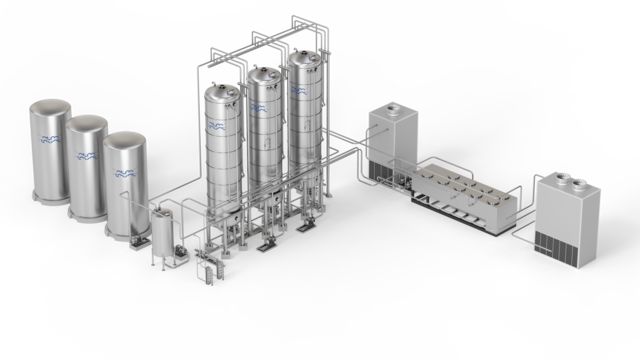Fat modification process systems
Moving from refined oils to specialty fats? Or extending your existing facilities to handle specialty fats? Alfa Laval has a full range of fat modification processes such as fat hardening, chemical or enzymatic interesterification, dry fractionation and semi-continuous deodorization. These can be integrated with an upstream refinery, work as a stand-alone process, or supply feedstock to downstream facilities such as margarine or shortening lines.
Benefits of our fat modification equipment
- Flexible design to handle daily production of different specialty fats
- Equipment can be designed for multiple purposes
- Minimal use of water and energy
Alfa Laval supplied us with a highly efficient plant, with the lowest production costs in terms of energy, hydrogen and catalyst consumption. It gives us unlimited flexibility to produce any type of fats we want,” - Alejandro Murillo, plant manager of CALSA – Cia Argentina de Levaduras S.A.I.C. – Argentina.
Documents
Process design for any specialty fats portfolio
Depending on the products your customers would like to produce and the raw materials available, you can choose between several different Alfa Laval solutions, or a combination of these.
Fractionation processes
The natural way to modify oils and fats
Modify feedstock from palm oil or animal fats using a direct, natural way to add greater value to the end product. Create products that match your customers’ exact specifications by separating the feedstock into liquid and solid fractions or combining different fractions.
Fractionation consists of gently cooling oils or fats in a precisely controlled process. The temperature is regulated to keep the fat in a partially liquid phase, crystallizing the solid fat content. A membrane filtration system separates the crystals from the liquid fraction. The result is two distinct products with different physical properties and melting points. This can be achieved with no chemical modification, making this the “natural” way to produce liquid oils and hard fats.
Batch-type dry fractionation system
For a batch-type dry fractionation system, the feedstock or refined palm oil enters the processing line. An external plate heat exchanger heats the feedstock to 65°C. Alternatively, the feedstock is heated inside the crystallizer to ensure the melting of crystalline structures before cooling takes place.
Next, the crystallizers reduce the feedstock temperature until the first crystals form, causing crystallization, and continue lowering the temperature to the desired degree of crystallization. The cycle time of the dry fractionation process of palm oil depends on the feedstock quality and final product quality desired.
After crystallization, the slurry passes through a membrane filter press, separating it into two products:
- Palm olein passes through the membrane and is forwarded to a storage tank.
- Palm stearin, which remains on the membrane, goes through further processing to remove as much olein as possible from the solid fraction for storage. Then, the stearin is dropped into a tank, melted by steam or hot water, and sent to storage.
Continuous dry fractionation system with batch-type option
The continuous dry fractionation process of palm oil is similar to batch dry fractionation. However, there are two differences in the configuration:
- A precooling section with plate heat exchangers to reduce the temperature of the palm oil before it enters the crystallizers.
- Pumps, one for each crystallizer, for continuous transfer of the oil from the crystallizers to the buffer tank. These speed up the process, cutting the time required to process the oil. as well as electricity and steam consumption.
Compared to batch mode, continuous dry fractionation results in higher olein yield (normally the most valuable product), reduces electricity and steam consumption by up to 40%, and add greater process flexibility to meet demand for products with iodine values (IV) 56.
DualFrac the Alfa Laval solution for continuous dry fractionation
The Alfa Laval DualFrac system enables operators to switch easily from continuous dry fractionation to batch dry fractionation to produce palm olein with higher IV values, including 58, 60 and 64.
Advantages of Alfa Laval DualFrac
Hydrogenation process
 The versatile way to modify fats
The versatile way to modify fats
Oils and fats from virtually all kinds of raw materials and ingredients can be modified into hard fats by altering their molecular structure. This is done by hydrogenation – the name given to the process in which hydrogen is chemically combined with unsaturated oils and fats, by making it link up with the double bonds of the unsaturated fatty acid chains. Essentially, this process consists of bubbling hydrogen gas through the oils, normally at temperatures of 150–200°C (302–392°F), under pressure and in the presence of a catalyst. This adds the hydrogen atoms to the double bonds of unsaturated fatty acids, either to reduce them or to produce fully saturated fats. Hydrogenation raises the melting point of oils and fats and improves a range of other properties, including taste and shelf life qualities. The diagrams to the right and below show two systems based on filtration and continuous centrifugal separation that Alfa Laval provides for catalyst removal.
Interesterification process
Want to combine an efficient, flexible production set-up with the ability to satisfy ever-changing customer demands? Interesterification can help.
By combining different oils and fats, interesterification makes it possible to produce hard fats from a wide range of raw materials – and in a way that conforms to modern market demands.
Traditional interesterification is carried out by using a chemical catalyst (normally sodium methylate) to bring about a regrouping of the position of the fatty acids on the basic glycerol molecule.
The mixture of oils and fats is pumped from the mixing tank to a steam heater and then to the reactor under vacuum conditions for drying. To improve drying efficiency, the oil is pumped through a recirculation section.
After drying the oil, a catalyst is introduced into the oil recirculation stream, using the special catalyst dosing device. When the catalyst reaction is completed, the oil is discharged to the post-treatment reactor. Here, the catalyst is deactivated with acid and the oil is treated using bleaching earth.
As an alternative, the catalyst can be deactivated with water in the washing tank. The soap generated in this process is removed using a disc stack centrifuge. The oil is then dried and sent to the post-treatment stage.
Interesterification does not affect the degree of saturation of the fat, nor the location of the cis-trans chemical bonds. It is largely done to control the consistency of the oil or fat at different temperatures, a parameter that is crucial for your customers in the food industry.
Customer's voice
CALSA – Cia Argentina de Levaduras S.A.I.C
The Alfa Laval hydrogenation plant supplied to CALSA features a feed tank, a drop tank and a dead-end reactor. Heat recovery is done by a highly efficient plate heat exchanger. Catalyst removal is undertaken in two steps, using direct filtration followed by a post-treatment system. The plant is fully automatic, controlled by a PLC unit.
Alfa Laval supplied us with a highly efficient plant, with the lowest production costs in terms of energy, hydrogen and catalyst consumption. It gives us unlimited flexibility to produce any type of fats we want,”
- Alejandro Murillo, Plant Manager of CALSA, Argentina.
Webinars for the Edible Oil industry
Our experts share know-how to optimize edible oil refining processes, remove impurities and volatile components for better product quality, safety and yield.


